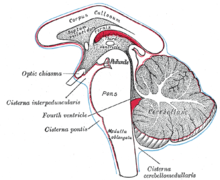- Duret haemorrhage
-
Duret haemorrhages are small areas of bleeding in the ventral and paramedian parts of the upper brainstem, (midbrain and pons). [1]
It is named for Henri Duret.[2]
Contents
Pathogenesis
They are secondary to raised intracranial pressure with formation of a transtentorial pressure cone involving the cerebral peduncles (crus cerebri) and other midbrain structures caused by raised pressure above the tentorium.
Kernohan’s notch is a groove in the cerebral peduncle that may be caused by this displacement of the brainstem against the incisura of the tentorium. The resulting ipsilateral hemiparesis is a false localising sign,[3] known as the Kernohan-Woltman syndrome.[4] This may succeed or accompany temporal lobe (uncal) herniation and subfalcian herniation secondary to a supratentorial mass.
Causes
The common causes are an acute hematoma, edema following trauma, abscess, or tumor.
Imaging can be difficult.[5]
Diagnosis
The Duret haemorrhage is demonstrated at CT or MRI.
Prognosis
It usually indicates a fatal outcome.[6] However, survival has been reported.[7][8]
Pathophysiology
The mechanism is uncertain[9] but is probably caused by the displacement of the brainstem stretching and lacerating pontine perforating branches of the basilar artery; venous infarction may play a role.
References
- ^ "Dorlands Medical Dictionary:Duret hemorrhages". http://www.mercksource.com/pp/us/cns/cns_hl_dorlands_split.jsp?pg=/ppdocs/us/common/dorlands/dorland/nine/10024444.htm.
- ^ Duret RL (April 1955). "[A rare and little known hemorrhagic syndrome.]" (in French). Brux Med 35 (16): 797–800. PMID 14378705.
- ^ Collier, J. The false localizing signs of intracranial tumour. Brain 27:490-508, 1904.
- ^ J. W. Kernohan JW, Woltman HW. Incisura of the crus due to contralateral brain tumor. Archives of Neurology and Psychiatry, Chicago, 1929, 21: 274–287.
- ^ Marupaka SK, Sood B (April 2008). "Atypical Duret haemorrhages seen on computed tomography". Emerg Med Australas 20 (2): 180–2. doi:10.1111/j.1742-6723.2008.01072.x. PMID 18377408. http://www.blackwell-synergy.com/openurl?genre=article&sid=nlm:pubmed&issn=1742-6731&date=2008&volume=20&issue=2&spage=180.
- ^ Parizel PM, Makkat S, Jorens PG, et al. (January 2002). "Brainstem hemorrhage in descending transtentorial herniation (Duret hemorrhage)". Intensive Care Med 28 (1): 85–8. doi:10.1007/s00134-001-1160-y. PMID 11819006.
- ^ Fujimoto Y, Aguiar PH, Freitas AB, de Andrade AF, Marino Júnior R (October 2000). "Recovery from Duret hemorrhage: a rare complication after craniotomy--case report" ([dead link] – Scholar search). Neurol. Med. Chir. (Tokyo) 40 (10): 508–10. doi:10.2176/nmc.40.508. PMID 11098635. http://joi.jlc.jst.go.jp/JST.JSTAGE/nmc/40.508?from=PubMed.
- ^ Kamijo Y, Soma K, Kishita R, Hamanaka S (November 2005). "Duret hemorrhage is not always suggestive of poor prognosis: a case of acute severe hyponatremia". Am J Emerg Med 23 (7): 908–10. doi:10.1016/j.ajem.2005.07.014. PMID 16291454. http://linkinghub.elsevier.com/retrieve/pii/S0735-6757(05)00265-2.
- ^ Fisher CM (May 1995). "Brain herniation: a revision of classical concepts". Can J Neurol Sci 22 (2): 83–91. PMID 7627921.
External links
- Images of Duret Hemorrhage from MedPix
CNS disease, Vascular disease: Cerebrovascular diseases (G45–G46 and I60–I69, 430–438) Brain ischemia/
cerebral infarction
(ischemic stroke/TIA)Intracranial hemorrhage
(hemorrhagic stroke)Extra-axialBrainstemDuret haemorrhageAneurysm Other/general Categories:- Cerebrovascular diseases
Wikimedia Foundation. 2010.

